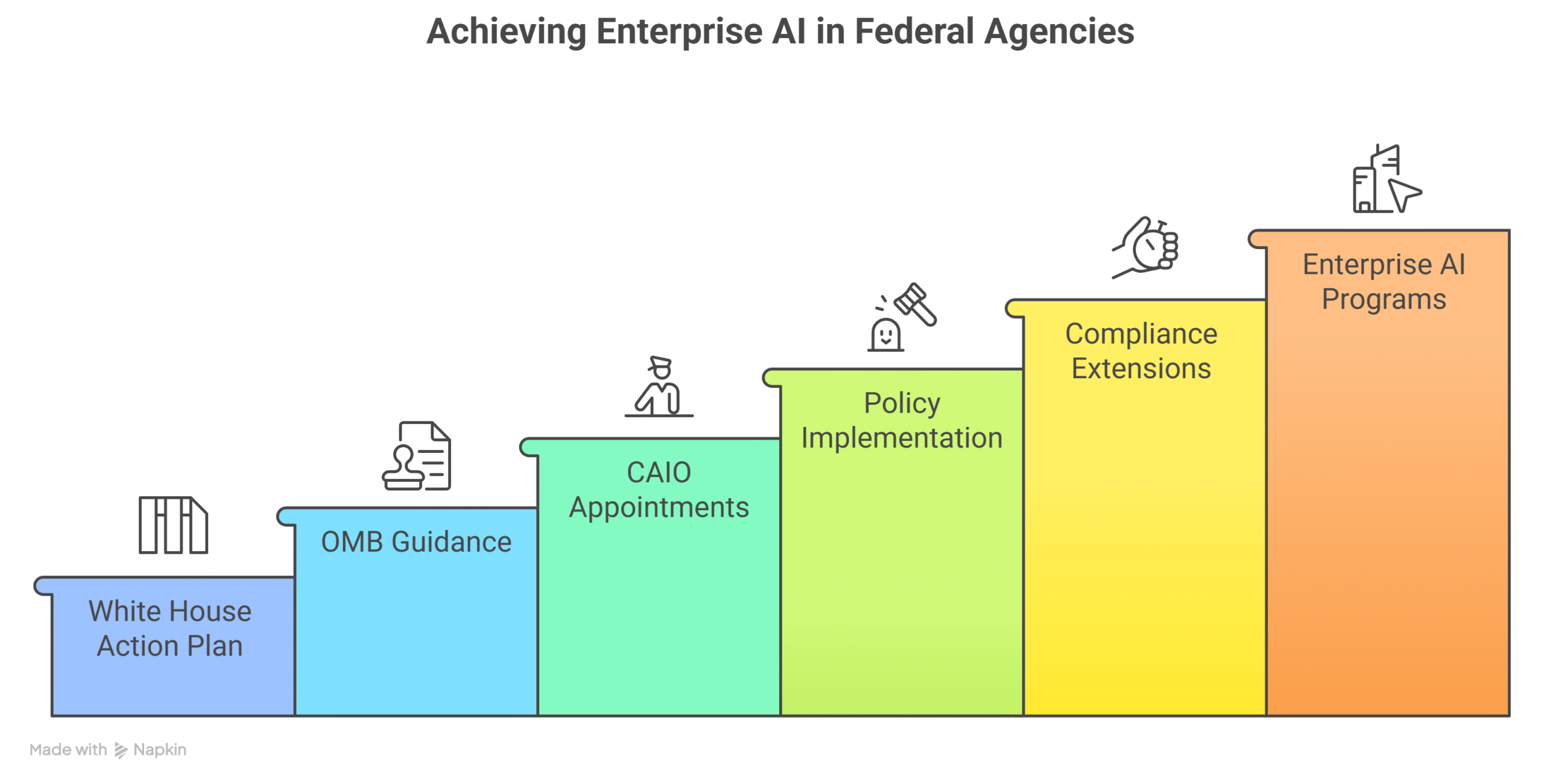

The U.S federal government has launched a series of bold initiatives and partnerships to accelerate AI in federal government operations. Recent reports highlight a dramatic uptick: for example, agencies publicly reported over 1,700 AI use cases in 2024, more than double the count from 2023. The Biden and now current administration’s AI strategies and new agency policies are pushing this momentum forward. These efforts from new Executive Orders to technology platforms are designed to streamline development, cut costs, and ensure government AI tools improve public services.
To advance Federal AI adoption, the White House and agency leaders have issued clear guidance. In mid-2025, the White House released a national AI Action Plan outlining priorities such as accelerating innovation, streamlining rules, and promoting open source models. For example, the plan explicitly notes that with AI tools in use, the Federal government can serve the public with far greater efficiency and effectiveness, by automating manual processes and improving citizen interactions.

Building on that vision, federal policy memos from the Office of Management and Budget (OMB) now instruct every agency to accelerate its use of AI under principles of innovation, governance, and trust. The new guidance reaffirms that agencies must invest in shared AI models and open-source code, and must maintain strict oversight of high-impact systems. Crucially, the memos require each agency to name a Chief AI Officer (CAIO) to lead these efforts; by mid-2024, at least 57 agencies had already appointed CAIOs as directed. These CAIOs and AI governance boards help ensure agencies develop a clear government AI strategy for responsible deployment.
In practice, this policy framework is already reshaping procurement and operations. Federal acquisition rules now favor competitive AI marketplaces and U.S.-made solutions, while barring unconsented use of government data to train private models. Timeline extensions give agencies until 2026 to bring all high-impact AI systems into compliance with risk-management rules. In short, Washington is aligning funding and regulation to make it easier for agencies to pilot and scale AI projects. The result: federal agencies are moving from experiments to enterprise AI programs faster than ever.
Many agencies are tapping industry partnerships and new platforms to jump-start adoption. A prime example is the General Services Administration’s (GSA) OneGov initiative, which offers government-wide contracts and tools for AI. In a landmark move, GSA announced partnerships to provide federal employees with leading AI tools at little or no extra cost. For instance, a recent agreement delivers Microsoft’s AI-enabled productivity suite (including Microsoft 365 Copilot) free for 12 months to eligible agencies. This Copilot-for-all offer is expected to save an estimated $3 billion in its first year, as agencies can automate routine tasks (like document drafting and email triage) and improve worker efficiency without licensing headaches. Similarly, the GSA now makes an open-source large-language model (Llama) available across government.
These corporate-government partnerships let agencies build, deploy, and scale AI applications using familiar tools. The Microsoft deal, for example, bundles AI into everyday software so analysts and clerks can leverage generative AI in word processing, data analysis, and customer service. By waiving fees and ensuring FedRAMP approvals, such deals let agencies modernize cloud infrastructure and share data more easily. In one roadshow with state and local leaders, agencies reported that these solutions dramatically cut cycle times and freed staff for higher-value work.
Another major accelerator is USAi, a new GSA-hosted AI lab and marketplace launched in 2025. USAi provides a secure, cloud-based evaluation suite where federal teams can experiment with generative AI (like chatbots or code generators) in a trusted environment. By centralizing AI tools and best practices, USAi avoids duplicating expensive pilots. According to GSA officials, USAi helps the government cut costs, improve efficiency, and deliver better services to the public while maintaining cybersecurity standards. Through USAi and OneGov, agencies can safely test new government AI solutions (for example, smart document readers or citizen-service bots) before committing to full procurement. These platforms thus translate policy into practice, putting innovation into the hands of each agency.
The results of these initiatives are evident across government. According to the Federal CIO’s inventory, AI use cases have surged: in 2024, agencies documented over 1,700 distinct AI projects, up from roughly 800 in 2023. That growth is not just in narrow test labs about half of these cases are developed in-house, showing that agencies are building their own AI tools and not just buying them. In practice, AI is being applied to boost mission-enabling functions like finance, HR, and cybersecurity nearly 60% of use cases, as well as to speed up government services. For example, the Social Security Administration uses AI to streamline disability claim reviews, and the Department of Labor uses AI chatbots for benefits inquiries.
By accelerating adoption, the government aims to deliver AI for public service improvements. The White House emphasizes that transformative use of AI can help deliver the highly responsive government the American people expect. Indeed, early outcomes are promising: agencies report fewer paperwork backlogs and faster response times in tasks using AI. And with broad tools now available, the focus is shifting to high-impact applications: healthcare agencies use AI for disease surveillance, veterans’ services use AI for fraud detection, and customs agencies use AI for threat identification. These examples reflect a wider trend as one report notes, US agencies represent 58% of the global government AI market, driven by national security demands and large data needs.

At the same time, agencies are building out data and compute infrastructure to support AI. Federal budgets have included billions for cloud modernization, high-performance computing (HPC) for AI research, and FedRAMP certification of key platforms. This means analysts and developers across agencies can access the powerful servers and secure environments they need. By knitting together cloud services, open models, and analytics tools, the government is creating a unified AI ecosystem for the public sector. These government technology trends from smart data sharing to cloud-native AI are now baked into IT modernization roadmaps at many agencies.
Behind the technology push, leaders recognize that technology alone isn’t enough. A recent industry study found that 70% of federal leaders believe workforce training is critical for AI success. As a result, agencies are investing heavily in upskilling programs. For example, agency training academies now include GenAI bootcamps and data science courses, often developed in partnership with universities and private firms. Recruitment efforts are also targeting data scientists and machine-learning engineers. This focus on talent ensures AI tools will be used effectively by well-prepared teams, turning investment into results.
Governance and ethics remain central. With more agency deployments, the government has clarified risk rules: AI systems deemed high-impact (those affecting people’s rights or safety) must undergo rigorous testing and oversight before use. Agencies now routinely publish AI risk assessments and require human review processes. This built-in trust and transparency was a core priority from day one. In practice, each new AI project is vetted by privacy and ethics boards. This balance agile innovation with strong safeguards defines the current government AI strategy.
Looking ahead, the government is also exploring agentic AI for complex workflows and advanced decision support. Task forces are assessing how such systems could autonomously handle tasks like field inspections or emergency response coordination. While early work is strictly controlled, the concept of government agentic AI indicates a future where agencies deploy semi-autonomous AI services. These efforts are tightly coupled with workforce development (people will oversee and guide these agents), ensuring that human officers remain in the loop.
In sum, the U.S. federal government is doubling down on AI adoption through strategic planning, powerful partnerships, and practical platforms. Policymakers have set clear objectives (as in the White House’s AI plans and OMB memos) and backed them with resources and incentives. At the same time, agencies are translating strategy into action by building AI into budgets, procurement, and daily operations. As one Federal CIO noted, waiting is not an option leaders are creating momentum and proving that AI in federal government can enhance efficiency and public service. For technology leaders and AI solution providers, this means the public sector is increasingly an AI-savvy customer: federal agencies now expect secure, scalable government technology solutions and are ready to partner on cutting-edge projects. With major deals in place and a clear mandate, the U.S. government is positioning itself at the forefront of the AI era, aiming to serve Americans better through intelligent, responsible innovation.
AI adoption in the U.S. federal government is driven by executive mandates, growing data demands, and the need to modernize services. Agencies are investing in scalable, secure platforms to improve efficiency and public engagement.
App Maisters delivers customized AI for public service, supporting Federal AI adoption through secure, compliant, and scalable solutions tailored to government needs.
Common use cases include fraud detection, intelligent document processing, automated claims handling, and real-time citizen support all enhancing public service delivery.
With over a decade of experience and a strong track record in government AI strategy, App Maisters offers certified, mission-driven AI development, deployment, and support services.
The federal government ensures ethical AI through oversight boards, risk assessments, and responsible governance, especially for high-impact systems affecting rights and public trust.
Commodo elementum, sed imperdiet nunc euismod etiam aliquet viverra

App Maisters Inc is a Federal Government SBA 8(a) Certified and Texas Hub Certified company. We are a leading developer of high-performance mobile apps, websites, and enterprise solutions, that are specially designed to meet Federal, State, Local government agencies and higher education needs.
